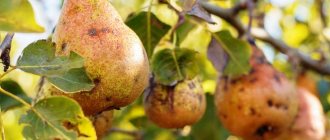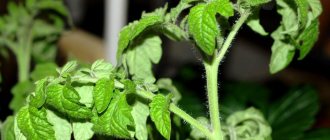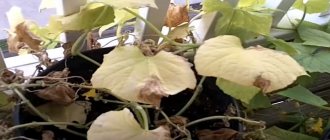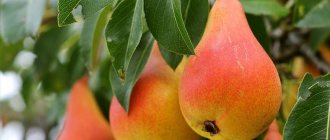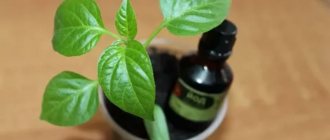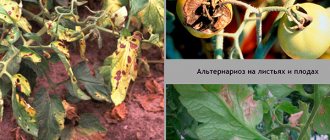With frequent mistakes in care, tomato seedlings weaken and are affected by various diseases and pests.
Dear readers!
For you, we have created communities on social networks in which useful articles and interesting ideas are published several times a day! Subscribe and receive useful content in a convenient format! Without quick and proper treatment, tomatoes may die. To prevent this from happening, it is worth understanding the diseases, which their detailed descriptions and photos will help with.
Common diseases of tomato seedlings with photos
Infectious diseases of tomato seedlings can be fungal, bacterial or viral. They differ in symptoms, severity and treatment methods.
Also, tomato seedlings can be affected by non-infectious diseases, which are caused by frequent errors in care.
Fungal diseases of tomato seedlings
More often, tomato seedlings are affected by fungal diseases. They can get into the seeds even at the stage of collecting planting material. They are often transmitted through soil, as well as through the use of unsterile utensils or equipment.
Indoor flowers can also infect seedlings.
Late blight
The disease is transmitted through contaminated soil, water droplets and even through the air.
At the first symptoms, dark spots with a white border form on the leaves of the seedlings. On the reverse side, the lesions are covered with a grayish coating.
Over time, the tomato stems become streaky and gradually dry out. With high humidity, tomatoes begin to rot.
What to do and how to treat
At the first sign of disease, it is important to remove all affected leaves. If the disease has spread to the stems, the seedlings will need to be destroyed.
Treat the remaining tomatoes and soil with copper-containing preparations.
REFERENCE! As a folk remedy, you can spray the planting with a solution prepared from whey and water (1:1).
Prevention measures
Before sowing, seeds should be soaked for 30 minutes. in a solution of potassium permanganate. Near planting, it is advisable to maintain humidity within 75% and ventilate the room daily.
Powdery mildew
The disease is transmitted by pests and indoor flowers. Progresses in conditions of high humidity and low temperature.
It can be recognized by a white coating, reminiscent of dust or flour in structure. Over time, the lesions increase in size and interfere with photosynthesis, causing foliage and stems to die.
What to do and how to treat
At the initial stages, seedlings can be treated with garlic infusion, potassium permanganate or a weak solution of vitriol.
If the disease is advanced, then you will need to use the drugs “Topaz”, “Skor” or “Previkur”.
Prevention measures
Do not allow moisture to stagnate at the roots. It is necessary to water the seedlings only when the soil dries out. When planting tomatoes, you must keep a distance and do not overuse nitrogen fertilizers.
Gray rot
The disease enters tomatoes through cracks and injuries. And it is provoked by excess nitrogen in the soil and high humidity. And it can be recognized by the gray powdery coating covering the stems of the seedlings.
What to do and how to treat
For treatment, treat the affected areas with fungicides such as Fundazol, Maxim, Trichodermin. Folk remedies include a solution of green soap, baking soda or boric acid.
Prevention measures
For prevention, seeds should be treated and soil and equipment should be disinfected.
Do not allow the soil to become waterlogged and air to stagnate. It is important to regularly ventilate the planting and plant tomatoes at the optimal distance.
Bacterial diseases of tomato seedlings
Bacterial diseases are transmitted through contaminated soil, equipment, and plant debris. They often infect seedlings in greenhouses and greenhouses.
Black spot
Develops at elevated temperatures and humidity. The leaf blades become covered with watery black spots, and dark streaks and dots form on the stems.
What to do and how to treat
Seedlings should be sprayed with copper-containing preparations (copper sulfate, Bordeaux mixture). Repeated treatment should be carried out after 10-14 days.
Prevention measures
Do not use unsterilized soil and untreated seeds.
Stolbur
When infected, leaf blades and shoots become purple or pink.
What to do and how to treat
Treat tomatoes with Aktara or Confidor. Spray the seedlings again after 7-10 days.
Prevention measures
Carry out preventive treatment of seedlings against diseases and pests.
Mottling
Translucent spots covered with an oily film form on the leaf blades. They increase in size and cover large areas. As a result, the leaves curl and die.
What to do and how to treat
Treat tomatoes with Fitolavin or copper sulfate.
Prevention measures
Prevent pests from appearing. Use sterile instruments and primer.
Viral diseases of seedlings
Viral diseases are transmitted by pests, and often the seeds themselves are affected by them. Therefore, it is important to purchase planting material from trusted suppliers, and be sure to treat it before sowing. Otherwise, you may lose the entire harvest, since viral diseases cannot be treated.
Mosaic
When infected, the leaf blades become covered with a pattern of yellow-green spots, reminiscent of a mosaic. Over time, they completely curl and fall off.
What to do and how to treat
Diseased tomatoes cannot be cured, so they must be removed immediately to prevent the spread of the virus. The remaining seedlings must be sprayed with a solution of potassium permanganate and fed with urea.
Prevention measures
Tools must be treated with bleach. For planting, it is worth using tomato varieties that are resistant to the disease. Planting material must be treated before sowing.
Streak
The disease is caused by the tobacco mosaic virus, which is transmitted through soil, pests and plant debris. When infected, brown stripes form on the leaves and stems, which eventually develop into cankers.
What to do and how to treat
The disease cannot be cured; all infected seedlings must be removed immediately.
Prevention measures
- For sowing, use only high-quality seeds collected from healthy tomatoes.
- Seedlings should be grown in good light and at an acceptable temperature.
- It is necessary to follow the rules of crop rotation on the site and remove all weeds.
- The beds need to be treated with insecticides.
Aspermia
The viral disease is transmitted primarily by aphids and others. But tomatoes can become infected through unsterilized soil or low-quality seeds. The affected crop slows down in development, and its leaves become deformed, become smaller and become covered with small spots.
What to do and how to treat
Aspermia cannot be treated, so you will have to immediately destroy all infected seedlings.
Prevention measures
We must not allow the invasion of pests that carry the virus. To do this, crops should be treated with insecticides. It is necessary to weed out weeds and disinfect garden tools, planting containers and greenhouses.
Non-infectious diseases of tomato seedlings
Frequent errors in care lead to the development of non-communicable diseases. And it is not difficult to cure such diseases. But to prevent the problem from recurring, you will need to create comfortable conditions for the seedlings.
Oedema
The disease, which is also called "dropsy" or swelling of the foliage, often occurs due to irregular watering. It is also provoked by poor ventilation and poor lighting in the room.
As a result of the disease, leaf plates and stems become covered with swellings - pimples. Over time, they die off, leaving behind gaps.
What to do and how to treat
If the time has come, the tomatoes should be planted in open ground or a greenhouse as soon as possible. If it is far from replanting, you will need to loosen the soil, ventilate the room and place the tomatoes at a distance.
IMPORTANT! Do not tear off affected leaves. This will further weaken the tomato. Over time, it will decide for itself whether to shed damaged leaves or not.
Prevention measures
To prevent the appearance of dropsy, you will have to normalize watering. Do not allow air to stagnate near tomatoes.
You will need to provide the seedlings with good lighting.
Damping off of sprouts and seeds
Because of this disease, the seeds do not germinate, and the emerging seedlings begin to decompose immediately.
The disease is associated with improper care of crops, when the planting is not ventilated daily.
As a result, an environment with a minimal amount of oxygen is formed under the film or glass, and it is detrimental to the seedlings.
What to do and how to treat
At the first signs of seedling ripening, you will have to reduce watering to a minimum. Near the plants you will need to maintain a temperature no higher than +25 °C and a humidity level within 65%.
ATTENTION! You will need to water the senets during treatment with a dark solution of potassium permanganate or Fitosporin M.
Prevention measures
To prevent damping off, it is necessary to ventilate the greenhouse in which the seeds are germinated daily.
It is also advisable to remove condensation from the shelter in order to reduce the humidity near the planting.
Burns
The disease develops when tomatoes are grown in too bright a place.
It is also caused by watering during the midday hours, due to which the water drops overheat in the sun and cause a burn. And such lesions look like yellow spots that form along the edges of the leaves.
Over time, the foliage curls, dries out and falls off.
What to do and how to treat
If the leaves are damaged by burns, they cannot be restored. But it is worth feeding the seedlings with preparations containing nitrogen (nitrophoska, azofoska, chicken manure solution).
Then the tomatoes will begin to quickly grow green mass, and the loss of burnt leaves will not become critical for them.
Prevention measures
It is worth growing tomato seedlings near the eastern window. In the south, tomatoes will need to be shaded from 12:00 to 15:00.
It is necessary to water tomatoes only in the early morning or at sunset so that the water drops do not overheat under the sun.
Leaf diseases
Leaves are the main indicator of tomato health. And through them, seedlings often signal diseases.
Chlorotic leaf curl
The disease is spread by whiteflies (pest butterflies). When infected, tomato leaves become smaller, wrinkled and turn pale.
What to do and how to treat
The disease cannot be treated, and infected tomatoes must be destroyed immediately so that the curl does not spread to healthy specimens.
Prevention measures
To prevent disease, seedlings should be treated with a solution of garlic, tobacco or yarrow, which repel whiteflies. It is also worth installing special traps and fumigators near tomatoes.
White leaf spot (septoria)
The disease develops at high humidity caused by frequent watering or rainfall.
Transmitted through contaminated soil, plant debris or pests.
Watery-white spots with a brown border appear on the leaves. They become brown, curl and dry out.
What to do and how to treat
Before treatment, it is worth removing the affected seedlings.
Seedlings need to be treated with copper-containing preparations, such as Bordeaux mixture, copper sulfate or copper oxychloride.
The soil will need to be watered generously with a solution of potassium permanganate and sprinkled with wood ash.
Prevention measures
Before sowing, it is necessary to sterilize the soil and planting material. You cannot grow seedlings near indoor flowers.
Cladosporiosis or brown spot
It often affects seedlings after transplanting into open ground. The disease is caused by fungi that become active in conditions of high humidity.
First, the lower leaves become infected and become covered with white and yellow spots. Over time, the lesions become brown in color and have a velvety texture.
What to do and how to treat
For treatment, seedlings need to be treated with fungicides “Quadris”, “Hom”, “Abiga-pik”. Repeat spraying will be necessary until all symptoms disappear, maintaining an interval between procedures of 7-10 days.
Prevention measures
For planting, it is worth using high-quality and treated seeds.
Tomatoes should be planted at a certain distance, avoiding crowding of the beds.
It is necessary to regulate watering and feed seedlings to increase their immunity.
Root system diseases
Diseases of the root system include bacterial and fungal blackleg and root rot. These diseases are dangerous and can lead to the death of seedlings in a short time.
Bacterial blackleg
The disease is transmitted through contaminated soil or planting material. The disease develops slowly and appears when the seedlings are already quite mature.
Bacteria attack the lower part of the stem, causing it to soften and rot. And if you pull the plant, it will break at the base, and mucus will flow from the place of the tear.
What to do and how to treat
To treat bacterial blackleg, the planting must be treated with a solution of potassium permanganate or copper sulfate (0.2 g per 1 liter of water).
REFERENCE! Traditional methods include infusion of onion peels or marigolds.
Prevention measures
For prevention, you need to treat the seeds in a solution of Fitosporin, Maxim or Vitaros. The fungicide solution should be added to the planting holes, using 5 ml for each.
Fungal blackleg
The disease has similar symptoms to bacterial blackleg, but it develops more rapidly. And often the disease leads to the death of seedlings immediately after picking, especially if the roots of the tomatoes were damaged during the procedure.
What to do and how to treat
To treat the disease, you need to treat the planting with the drug Trichodermin. To prepare the solution, dilute 20 g of fungicide in 5 liters of water.
You will need to spray the seedlings until complete recovery, maintaining an interval of 7-10 days between treatments.
Prevention measures
Often fungal spores are present on the seed coat. And to prevent their development, planting material must be treated with potassium permanganate or fungicides before sowing. Density of planting, excessive watering, and sudden temperature changes should not be allowed.
Root rot
Tomatoes develop more slowly, their lower leaves turn yellow and wither. And if you dig up a seedling, you can see rotting roots.
The disease is provoked by excessive moisture, planting in contaminated soil and the use of unripe humus as a top dressing or soil component.
What to do and how to treat
If a small part of the root is affected, then the rotten shoots need to be removed. The tomato itself will need to be placed in the Trichoderma solution for 20-30 minutes. Then the seedling needs to be planted in the ground, after watering it with a fungicide.
You will need to deepen the plant almost to the cotyledon leaves.
Prevention measures
To prevent root rot from occurring, you will need to regulate the watering regime. Do not use unripe compost or fresh manure to feed tomatoes. It is necessary to grow tomatoes at a distance, avoiding planting density. And water the plants only with warm and settled water.
Bacterial diseases
Bacterial wilt
The causative agent of bacteriosis is Pseudomonas solanacearum. When affected by an acute form of the disease, it is impossible to detect it, and the plant simply withers and dies. In the chronic version of the disease, brown longitudinal stripes begin to appear on the stem. The leaves begin to turn yellow, the plant’s growth slows down, the existing fruits grow small and fall off.
When cutting the stem, you can find brown-yellow rings on the vessels of the plant, which are filled with pathogenic mucus. What appears to be blossom end rot appears on the fruit and the fruit turns brown on the surface. Bacteria are found in the soil, after which they enter the stem through the roots.
Tomato stem necrosis
The causative agent is Pseudomonas corrugata. The manifestation of necrosis occurs during the formation of tomato bunches. Spots of necrosis on the stems are brownish-brown, elongated and depressed. A bacterial mass accumulates in the vessels of the plant, which then flows out of cracks and wounds.
When cutting the stem, necrosis of the pith can be detected. The necrosis itself proceeds as follows: first the core is saturated with water, then it becomes glassy, then it darkens and dries out. At the same time, the stem looks healthy outwardly. The leaves at the top of the plant wither, darken and lose turgor. The fruits are covered with a network of light veins; when cutting them, necrosis of the seed coat can be detected.
Pests of tomato seedlings
In unfavorable conditions, tomato seedlings can be attacked by the following pests:
| Name | What does it look like | Fighting methods |
| Whitefly | A small fly with white wings. Pests can be recognized by a shiny coating covering the upper part of the leaves. | Adult pests can be caught using sticky traps. To destroy the larvae, seedlings should be treated with insecticides “Confidor” and “Karbofos”. |
| Spider mite | A small pest that is difficult to notice with the naked eye. But his command is indicated by a thin sticky web accumulating in the axils of the leaves. | To kill insects, you can spray the seedlings with an alcohol solution, infusion of garlic or onion. The insecticide "Karbofos" will help get rid of a large colony. |
| Aphid | Small insects that attack the stems and leaves of seedlings. | Among the folk remedies, tobacco, soap or ash solution helps to destroy aphids. If there are a lot of pests, then you should use the preparations “Ratibor” or “Proteus”. |
| Cutworm | A moth-like moth. More often it attacks tomato seedlings after planting in open ground. | You can get rid of the pest using the insecticides “Fitoverm” and “Dendrobacillin”. |
| Sprout fly | The insect resembles an ordinary fly. Its larvae feed on tender shoots and can destroy most of the seedlings. | To prevent the appearance of the pest, it is important to treat the seeds before sowing. To combat insects, you need to use the drugs “Iskra”, “Aktellik”, “Fufanon”. |
How to grow healthy seedlings, useful tips
In order for seedlings to grow healthy and strong, a number of conditions must be met:
- Select the right seeds, carry out their pre-sowing treatment and observe the recommended timing of sowing seeds.
- Select soil with a balanced nutrient composition and disinfect it.
- When sowing, follow the planting pattern to avoid excessive density of seedlings, which often leads to disease.
- Observe the lighting, watering and temperature conditions necessary for tomatoes.
- Make a pick in a timely manner. At the same time, discard diseased and weak plants.
- Harden off seedlings before planting in open ground.
If you followed these rules, the seedlings will take root well in the future and quickly adapt to the new location.
Features of caring for tomato seedlings to avoid diseases
To prevent the occurrence of diseases and pests, when growing tomato seedlings you should adhere to the following rules:
- Tomatoes should only be sown in a sterilized substrate and container. Before the event, planting material should be treated. The soil must have a certain composition and acidity suitable for tomatoes. It is better to use a universal mixture marked “For tomato seedlings.”
- Maintain distance between seedlings. Densified plantings interfere with good air circulation and provoke an increase in humidity.
- All diseased tomatoes must be removed promptly. Then diseases will not spread to healthy tomatoes.
- Near planting, you will need to maintain good lighting and temperature within +18...+22 °C.
- Tomatoes should be watered as the top layer of soil dries, avoiding waterlogging. You need to pour water at the root, trying not to get on the stems and leaves. Before the event, the water must be left for 24 hours and heated to +18…+22 °C.
ON A NOTE. You will also need to spray the seedlings with insecticides and fungicides for preventative purposes.
Diseases of seedlings and their treatment
Processing of seedlings
Plants need to be treated depending on the disease and the type of plant; the most common substances for these purposes are:
- Copper sulfate and fungicides.
- Trichodermin.
- Copper chloroxy solution or 1% Bordeaux mixture.
- 1% suspension of colloidal sulfur.
- Pseudobacterin-2.
- Abiga Peak.
Prevention
To effectively prevent tomatoes, we recommend the following measures:
- moderate watering;
- use of potash and phosphorus fertilizers;
- hilling;
- compliance with planting schemes;
- destroy falling fruits and leaves;
- soil sterilization;
- ventilation of greenhouses (read about all diseases of tomatoes growing in greenhouses here);
- carry out disinfection;
- soil monitor the soil temperature.
Pests
Pests cause a lot of trouble for gardeners, because they can significantly spoil the harvest at their summer cottage. The main pests of tomatoes are:
- The cutworm is a nocturnal pest that lays eggs on tomato leaves.
- Wireworm – damages stems and roots.
- Mole cricket - gnaws stems underground.
- Whitefly - uses plant sap for nutrition, which is why the leaves become covered with plaque.
How to treat tomato seedlings from diseases and pests
Prevention will help prevent infection of seedlings, and for it you will need to treat the plants according to the following scheme:
- When the seedlings have 2 true leaves, they need to be watered with Previkur, Infinito KS or Consento fungicides. The working solution should be prepared according to the instructions specified by the manufacturer, without exceeding the dosage. This treatment will prevent the development of root rot.
- When the 5th true leaf appears on the seedlings, the plants need to be treated for pests. It is worth using a solution of the Confidor insecticide, diluting 15 ml of the drug in 10 liters of water.
- 3-5 days before planting in the garden, the plants should be sprayed with Ridomil Gold. To prepare the solution, you need to dilute 20 g of fungicide in 10 liters of water. It is worth adding urea (20 g) to the liquid, which will improve the effect of the drug and feed the seedlings.
ATTENTION! Plants should be treated early in the morning or late in the evening. During the process, solutions should be applied only to the soil, being careful not to get on the leaves and stems of the seedlings.
Non-communicable diseases
Apical necrosis
It occurs in the area of the flower scar in the form of whitish and brown spots that appear on the fruits. With internal damage, necrosis covers up to 1/3 of the apex of the fetus.
The disease is also occasionally characterized by the formation of black and brown depressed spots. Top rot on tomatoes occurs when there is a lack of Ca2, acidity of nutrient solutions, high air humidity, and elevated temperature. There are hybrids that are resistant to blossom end rot, for example F1 Bolero.
Fruit cracking
It can occur under conditions of heavy watering in hot weather or at elevated temperatures, due to which the skin becomes hard and then cracks. Excessive plucking of bushes can also lead to cracking, since the plant will have nowhere to put excess moisture, and it will direct it into the fruit.
A lack of nitrogen, phosphorus, copper, potassium, and calcium can also lead to the formation of cracks in fruits.
Yellow or green spot near the stalk
This is a fairly common phenomenon and there are several main reasons.:
- A varietal feature, the so-called GREENBACK, of a particular variety or hybrid for which this is considered the norm, for example, “Black Moor” tomatoes, “mushroom basket”.
- The second reason is an unbalanced diet. Application of fertilizers without taking into account the composition of the soil and nutrients in accessible form, high or low acidity, abuse of fertilizing, especially nitrogen, causes uneven coloring of the fruit.
- The third reason for incomplete ripening of tomatoes may be a simple lack of sunlight, due to the “thickness” of the planting, but also, in turn, a lot of sun (with insufficient watering) can negatively affect the ripening of the fruit.
Silvery spots
Basically, this is not recognized as any disease, but is only a deviation from the norm. The reasons are as follows:
- sharp temperature fluctuations;
- genetic abnormalities.
Oedema (edema) - swelling of leaves
It is also not recognized as a disease. This happens when the soil is warmer than the air or at high humidity. May be accompanied by the appearance of raised spots similar to white mold. The main reason is overflow of plantings. It is necessary to ventilate greenhouses more often and normalize humidity.
Answers to frequently asked questions
When growing tomato seedlings, gardeners often ask the following questions:
How to quickly sterilize soil prepared yourself?
The substrate can be heated in the oven at +90 °C (45 min).
How to treat seeds before sowing?
Planting material should be soaked in potassium permanganate (1%) for 20 minutes. You can use solutions of fungicides “Fitosporin-M”, “Maxim” and “Skor”.
How to treat for protection and prevention?
The best results are obtained by timely adoption of preventive measures to combat various diseases of tomato seedlings. Even at the planting stage, it is important to properly prepare the seeds and soil. To do this, the seed material is soaked in a disinfectant solution:
- potassium permanganate;
- hydrogen peroxide;
- boric acid;
- copper sulfate.
Irradiation under an ultraviolet lamp is possible.
Often, fungal spores and virus strains “overwinter” in the soil, so before planting, it also needs to be neutralized. For example:
- steam;
- bake in the oven;
- pour boiling water over;
- freeze in the refrigerator.
For chemical treatment, fungicides (Fitosporin, Planriz, Barrier, Extrasol, Glyokladin) or potassium permanganate are used.
Sometimes it is necessary to normalize the acid-base balance of the soil. To “deoxidize” ash, chalk, slaked lime, dolomite flour and other alkalis are added to the soil.
Acidic soils are more prone to acidification and decay than to the processes of organic decay, and this contributes to the development of pathogenic microflora.
Pre-sowing seed treatment
If you use seeds in bags purchased in a store for sowing, they do not need to be disinfected before planting. Agricultural company workers process planting material in production. It’s another matter if a decision is made to use your own seeds from tomatoes grown on the site or if seeds of unknown origin are purchased for sowing (for example, at a spontaneous market).
In this case, the seed must be disinfected, because it could be infected with pathogenic bacteria or fungi. Seeds are treated by soaking in solutions based on:
- potassium permanganate - bright pink;
- brilliant greens – 1 ml per 100 ml of water;
- "Chlorhexidine" - a pharmaceutical product is used in a concentration of 0.05%.
In these compositions, the seed material is left for 30 minutes for the purpose of disinfection. You can also use the drug "Fitosporin-M". The powder is diluted at the rate of 1.5 g per 150 ml of water, the soaking time of the seeds is 1.5-2 hours.
What are the diseases of tomatoes?
Tomato diseases are divided into groups:
- mushroom;
- bacterial;
- viral;
- non-infectious.
To prevent infectious diseases, it is necessary to carry out preventive measures, starting with sowing seeds. Modern plant protection products make this possible. In addition, plants very often suffer from improper care. To get a good harvest, you should know the basic rules of agricultural technology. And, most importantly, do not forget what to plant next in the garden.
If disease prevention is not carried out or carried out untimely, during the summer it is possible to treat only fungal diseases of tomatoes. If signs of bacterial or viral diseases appear, the diseased plants should be promptly removed and destroyed.
Mosaic
A dangerous viral disease that equally affects tomatoes in greenhouses and open ground. When infected, the plant does not die, but cannot fully develop. This leads to a decrease in yield and loss of taste. The causative agent of mosaic is the Tobacco mosaic tobamovirus virus. Crop losses due to this disease are 30-35%.
Symptoms
The mosaic appears on the leaves as alternating spots of green and yellow. Also, individual areas darken, and the plates themselves curl. With the rapid progression of the disease, characteristic spots appear on the fruits. The mosaic gives the impression that the bush was scalded with boiling water.
Treatment and prevention
The virus is carried by insect pests, and it can also enter an area with contaminated soil or seeds. Therefore, to prevent the development of the disease, it is recommended to treat the seedlings before planting in a permanent place in a solution of potassium permanganate for 20 minutes.
Affected bushes must be destroyed, since the mosaic cannot be treated.

